By the close of the 19th century Arts and Crafts had become the dominant style in the design of domestic interiors for the British middle and upper classes. Drawing on national and regional traditions, the Arts and Crafts home celebrated individual expression, simplicity and 'honest' forms. Our collections contain a huge number of items – from cutlery to furniture – that express Arts and Crafts ideals. These include objects designed by many of the Movement's most well-known figures, including William De Morgan, Charles Robert Ashbee, Philip Webb and Charles Voysey.
Arts and Crafts designers didn't just want to create beautiful, handcrafted objects. They were also interested in trying to integrate buildings and their interiors in unified 'total' design schemes. This meant designing furniture, metalwork pieces, ceramics and other objects specially to fit a new, socially transformative model of domestic space – the idea that living surrounded by simple, 'honest' designs improved a person's outlook and moral character. Homes designed according to Arts and Crafts principles would have looked daringly simple to Victorians used to the ornate interiors that had been fashionable since the mid-19th century.
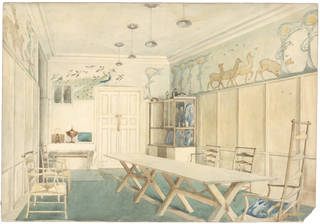
Utility was of paramount importance to the Arts and Crafts designer, so there was no extravagant or needless decoration, and the construction of an object was often exposed. Preserving and emphasising the natural qualities of the materials was also key, as was the production of simple, often vernacular (relating to the ordinary, the domestic and the functional) forms. Nature was an important source of ideas, with many Arts and Crafts patterns inspired by British flora and fauna.
Key British names in Arts and Crafts design for the home include:
Charles Robert Ashbee (1863 – 1942)
Like many of his Arts and Crafts associates, Charles Robert Ashbee worked across a range of different design disciplines, ranging from interior decoration to jewellery. He established the Guild and School of Handicraft in 1888 to help realise the potential of craftspeople working in the East End of London. This organisation specialised in metalworking, and in the late 1890s Ashbee and his associates began to design and produce silver tableware. Reacting deliberately against factory production, the Guild produced pieces whose hand-made status was emphasised by details such as visible hammer marks. Ashbee's designs were celebrated for their simplicity and focus, and his restrained aesthetic had a significant influence on contemporary silver design not only in Britain but also Europe and America.
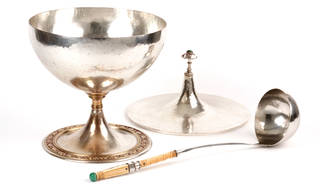
Ernest Barnsley (1863 – 1926) & Sidney Barnsley (1865 – 1926)
Ernest Barnsley and his younger brother Sidney both trained as architects. After graduation Sidney completed his training at London architect Norman Shaw, a proponent of 'Old English' style, and Ernest at John Dando Sedding, an influential Arts and Crafts designer. It was through Ernest working for Sedding that he and later Sidney met Ernest Gimson [see below], a fellow trainee architect. In 1893 Gimson and Sidney Barnsley persuaded Ernest to leave his accelerating architectural career to join them in setting up a craft community in Sapperton in Gloucestershire, that was to focus on working with local people and materials. Here the Barnsley brothers produced furniture that adhered to the Arts and Crafts ideal: visible construction, simple structures and limited decoration.

William Arthur Smith Benson (1854 – 1924)
As a young man William Arthur Smith Benson completed his training in the office of Basil Champneys, an architect who helped revive the late Gothic style favoured by the Arts and Crafts Movement. Through Champneys Benson was introduced to William Morris, who encouraged him to establish a small workshop for the production of turned metalwork. Unlike Morris, Benson fully embraced the potential of mechanical production and designed exclusively for it. A founder member of the Art Workers' Guild (established in 1884), Benson created a commercially successful range of oil and electric light fittings, and household utensils in copper brass, electroplate and silver. Following Morris's death in 1896, Benson became Managing Director of Morris & Co., for which he also designed furniture and wallpaper.
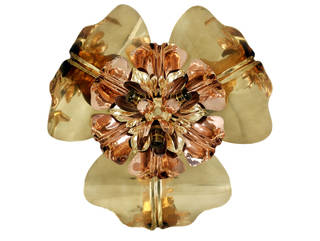
Godfrey Blount (1859 – 1937)
Godfrey Blount was a painter who was deeply influenced by the ideas of leading art critic of the Victorian era, John Ruskin. In 1896 Blount and his wife Ethel moved to Haslemere in Surrey to join Ethel's sister, Maud, and her husband Joseph, who had established the Haslemere Peasant Industries. This group of workshop-based craft enterprises together formed an artistic community that aimed at obtaining 'the double pleasure of lovely surroundings and happy work'. The Blounts later set up their own enterprise called the Peasant Arts Society, which used local women to produce hand-woven pile carpets and simple embroidered appliqués on linen known as 'peasant tapestries'. Made to Blount's designs, the tapestries were used as door curtains, casement curtains, bed spreads and bed hangings, and became very fashionable in artistic circles.
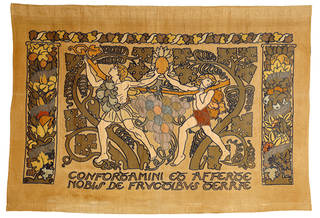
Arthur Stansfield Dixon (1856 – 1929)
Trained as an architect, Arthur Stansfield Dixon was a friend of William Morris and Charles Robert Ashbee, and also knew Philip Webb, the Arts and Craft Movement's leading architect. Dixon designed a number of pioneering Arts and Crafts-style buildings in Birmingham, and also developed a reputation for designing objects in metal. In 1890 Dixon founded and became the chief designer of the Birmingham Guild of Handicraft, which produced the city's first Arts and Crafts metalwork. With their simple forms and deliberately emphasised hammer marks, pieces designed by Dixon are strong expressions of a 'handmade' aesthetic. Their plain design and simple construction must have seemed rather naked to most Victorians, but pleasingly 'honest' to those who supported the anti-industrial ideas that Dixon had helped make newly fashionable.

Ernest Gimson (1864 – 1919)
As a young architect Ernest Gimson was recruited to the office of John Dando Sedding, a well-known church architect. It was here that Gimson met first Ernest Barnsley and through him, his brother Sidney, both fellow architect-designers with whom Gimson later set up a crafts-based artistic community in Sapperton in Gloucestershire. Concentrating mainly on furniture, Gimson and the Barnsleys integrated their work into the life of the local community by training villagers to become craftsmen. The designers also learned skills themselves: Gimson was taught by a 'chair bodger' to make traditional ladder-back chairs. In line with Arts and Crafts ideals, Gimson's designs are very simple, often using local wood, exposed pins and dovetail joints or, in his later metalwork pieces, features such as rivets.
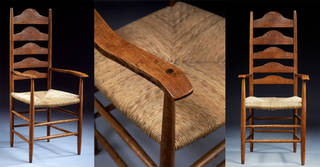
Charles Rennie Mackintosh (1868 – 1928)
The designer of a number of innovative and unapologetically modern spaces in Glasgow – including the city's famous School of Art – Charles Rennie Mackintosh created bespoke objects to match the pared-down aesthetic of his architectural schemes. Although he also produced metalwork, textiles and stained glass, it is Mackintosh's furniture that remains the best-known element of his non-architectural output. Craft-based production and a respect for regional tradition allied him with Arts and Crafts thinking, as well as a willingness to expose the details of construction. Throughout his career Mackintosh worked closely with his wife, Margaret Macdonald, a fellow art graduate. Their collaborative schemes are notable for the integration of 'feminine' graphic forms (such as the instantly recognisable pink 'Glasgow Rose') into plain and increasingly rectilinear furniture and other objects.

William De Morgan (1839 – 1917)
William De Morgan was a friend of William Morris, and designed stained glass and tiles for Morris's company, Morris, Marshall, Faulkner & Co. De Morgan is best known for his prolific production of tiles, which were inspired by the craft pottery of the Middle East and the Italian Renaissance. Hand-painted tiles – most commonly set in fireplaces – became a regular feature of Arts and Crafts interiors from the 1860s onwards. De Morgan set up and ran his own workshops, and acquired the expertise to fire lustre glazes in the manner of historical ceramics from the Islamic world and Moorish Spain. He also produced some of the most distinctive wares of the art pottery movement, creating decorated vases and bowls that represent the antithesis of standardised factory ceramics.

William Howson Taylor (1876 – 1935)
'The Ruskin Pottery' was a ceramics studio in Smethwick, Staffordshire that was founded in 1898 by Edward Richard Taylor, an artist and teacher who was influential in his role as the head of the Birmingham Municipal School of Arts and Crafts. Taylor's pottery was named after the critic, social theorist and artist John Ruskin, whose reformist principles on beauty, craft and quality Taylor wanted to apply in the production of pottery. Under the management of Taylor's son William, the 'Ruskin Pottery' became one of the Arts and Crafts Movement's most creative ceramics studios. Inspired by Chinese pottery of the Sung and Ming dynasties, William and his design team experimented with new kinds of glazes, producing innovative, brightly coloured tea services, pots, vases, buttons, bowls and jewellery.

Charles Voysey (1857 – 1941)
Having trained with leading practitioners in the design of both churches and country houses, Charles Voysey set up his own architectural practice in 1881. An advocate of honest, thoughtful design, Voysey created a series of buildings whose sparsely decorated and plainly furnished interiors adhered strongly to Arts and Crafts principles. Alongside his architectural work, he made a great success in designing wallpaper and fabrics, and also produced tiles, ceramics and metalwork, as well as a large number of furniture pieces. Deliberately simple and characterised by the subtle use of curves and restrained decoration, Voysey's tables, chairs and desks are sophisticated yet informal. Taking a minimalist, 'less is more' approach that would have seemed revolutionary at the time, Voysey anticipated the open, unfussy style of Modernism.




Philip Webb (1831 – 1915)
Philip Webb is best known as the architect of Red House (1859), the pioneering Arts and Crafts home commissioned and co-designed by William Morris. Webb also created much of Red House's bespoke furniture, and went on to become the successful chief designer of furniture for the firm he set up with Morris and a number of their contemporaries. Webb established a benchmark for Arts and Crafts furniture, producing handcrafted and restrained designs that were evocative of the medieval era, and later, traditional rural styles. Webb also produced designs for smaller-scale pieces including metalwork, tableware, glassware and tiles, and was also a lead designer in the decoration of the 'Green' Dining Room at the South Kensington Museum (now the V&A).

Discover more about Arts & Crafts.


